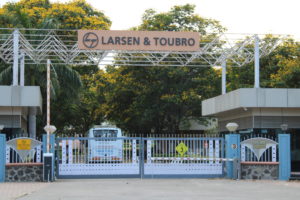Post-lockdown industrial revival remains a distant dream

Skeletal operations have begun at some units, including this plant of Larsen & Toubro at Ahmednagar (MIG Photos/Varsha Singh)
Central government’s conditions for letting select industries restart are proving to be a non-starter.
Over a week after the central government announced easing of the lockdown for some industries, in an attempt to revive the national economy that is passing through the worst crisis in its history, there have been few takers from the business. For most of the businesses, the conditions imposed by the government were not only far too stringent, but also imposed an unacceptably high economic cost on the industry.
The central government mandated that companies must either provide residence to the workers on or near their units or organise free transportation for the workers from their residence to the workplace. In addition, the companies were also meant to ensure that the workers follow social distancing norms even on the shopfloor. While some of the larger companies could have been in a position to accept these conditions and restart work, for most of the small and medium enterprises, the cost imposed by these conditions made the entire unit unviable and hence refused to restart work as per the suggestions of the government.
The extremely low uptake of the government’s recommendations by businesses is evident in the industrial area in Ahmednagar, a small manufacturing centre about 250 km east of Mumbai. Ahmednagar is home to several large companies such as Larsen & Toubro as well as Crompton Greaves and Videocon, among others. Diversified conglomerate Larsen & Toubro has a switchgear manufacturing unit in the industrial area. Vice president of the company, Arvind Pargaonkar, says that after meeting the district administration, the company decided to restart its unit on April 27. However, currently, it has only asked about 50 workers to report to work and the plant would operate at about 5-10 pc of its capacity. “Restarting a factory after a shutdown of more than a month requires a lot of preparatory work and that is what we are currently doing. Cleaning the shop floor and the machines, restarting compressors, power units and other machines and only then would we start actual production,” he says.
He adds that the company is following all the basic conditions laid down by the government, such as transporting workers to the factory and back home as well as sanitising not just the machines and the plant as well as offices, but also the buses that carry the workers. However, Pargaonkar is quick to add that the current level of operations within the factory as well as the situation prevailing outside hardly make it a viable proposition to ramp up the production and bring back the entire workforce.
“Some of our vendors are not in Ahmednagar, they are in Pune, Mumbai and even abroad. Hence, the supply chain remains disrupted and will remain disrupted till the situation comes back to normal,” he adds. The company is hoping that on May 4, the government would further liberalise the lockdown conditions, if not withdraw it altogether. Only then will it become viable for companies like L&T to restart their full operations. Pargaonkar says that each day the unit was shut cost them about INR 40 million in loss, but goes on to say that the lockdown was necessary to save lives of the people and to contain the spread of the pandemic in India. Now, he hopes that the government may go in for a graded lockdown to allow the supply chain to restart.
The social distancing norms being imposed by the government pose yet another challenge for businesses. Pargaonkar goes on to say that L&T has been complying by the government’s order on maintaining social distancing in the factory. However, if the norms continue when the factory resumes production at full capacity, the company would have to significantly redesign its shopfloor. “We have to redesign our layouts for assembly as soon as we will be starting our operations in order to respect the social distancing norms. We have been redesigning the assembly lines, but at some places it can be very difficult,” he concludes.









